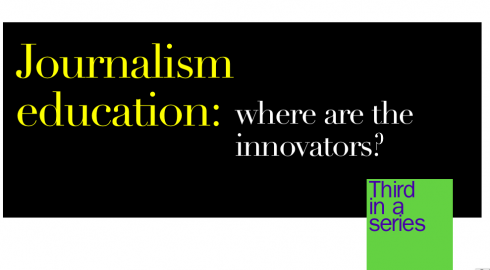

I have interviewed Dr. Leslie-Jean Thornton, a member of the faculty at the Cronkite School of Journalism and Mass Communication, whose program is all inclusive, and, to me, approaches mult-platform storytelling education with an emphasis on what she describers as “multimedia/storytelling literacy”.
Mario: When do the new storytelling strategies get introduced? Beginning reporting?
Prof. Thornton:
We require an online media course of all journalism students at the Cronkite School, and encourage them to take it as early as they can. Where a few years back it was mostly seniors and graduate students, now it’s sophomores, juniors… This has let us add elective and capstone courses that build on those skills. Our approach comes directly from what journalism/new media leaders said was most needed: the ability to “think” multimedia. That ability to conceptualize goes hand-in-hand with knowing what can be done and with what ease. Our new professional masters program starts with immediate immersion into a bootcamp that features multimedia accompanied by “print” and broadcast reporting. On the first day, I have them thinking about different ways to source, show and tell stories (I teach the multimedia component). To increase their multimedia/storytelling literacy, it’s essential they see many examples – good, bad and routine – and learn to assess them critically in terms of journalism, design, technique and practicality.
We feature some of the best of our students’ work in the Cronkitezine (http://cronkitezine.asu.edu). In here, you can find examples from classes in basic reporting, copy editing, in-depth reporting, online media, magazine, broadcast and more. But many of their storytelling talents are nurtured in their own or class blogs or through shared spaces such as YouTube. We also have a news service where students gain storytelling experience.
Mario: What are the major challenges for you as an instructor?
Keeping up with all the work being done, staying current with software and social media tools, teaching classes composed of students who range from near-technophobes to enthusiasts. Again, a focus on the story – on what information needs to be told – and on the best means of communicating and researching that story is what gives the endeavor meaning. This applies whether the “story” is a news brief, a feature, a complex analysis or a professional portfolio.
From a strictly practical standpoint, finding enough hours in the day to give the feedback they need is a challenge. Multimedia journalism done right is time-intensive on almost all levels, whether you’re a student, professor or consumer. If you’re working with someone from a different media “culture” background (video, broadcast, print, design, etc.), respect and an understanding of (if not proficiency in) where that person’s coming from is more important than one might imagine.
Another challenge is providing students with real-time application of their skills in a meaningful way. The fall 2009 elections in the U.S. were a boon for multimedia journalism professors. Cronkite students used digital tools to provide breaking news, color reports and features to local, national and international publications, and some took part in liveblogging a debate some 2,500 miles away through collaborative Web software – contributing to a collaborative story, as it were. Unifying events, unifying topics – getting the right one. Tough.
Link to see the best of the Cronkite students’ work:
http://cronkitezine.asu.edu
Contacting Prof. Thornton:
leslie-jean.thornton@asu.edu
Twitter: @ljthornton
Coming up in the series
TOMORROW: We profile Hofstra University of Long Island, New York, where innovative work is taking place in a small department with only 5 journalism professors, including Mo Krochmal, who teaches Online Journalism. As Krochmal put it to me:
“Storytelling for a multimedia world is slowly working its way into our program as much as from pressure from the dynamic environment the media world finds itself in, as well as through our initiatives.”
How the following J-schools carry out innovation:
University of Tennessee
Syracuse University’s S.I. Newhouse School of Public Communications
Ball State University
University of Miami
Follow the Marios

Two Marios. Two Views.
Follow Mario Jr. and his blog about media analysis, web design and assorted topics related to the current state of our industry.
http://garciainteractive.com/
Visit Mario Sr. daily here, or through TweetsByDesign (www.twitter.com/tweetsbydesign)
:
To read TheRodrigoFino blog, in Spanish, go:
https://garciamedia.com/latinamerica/blog/
TheMarioBlog posting #267